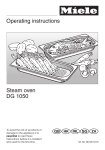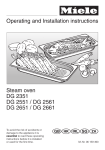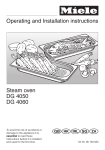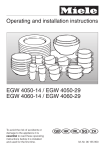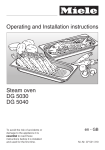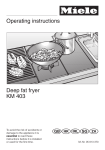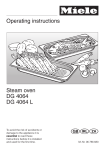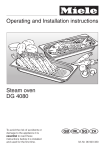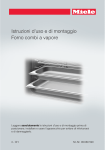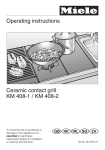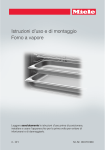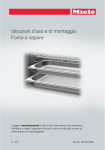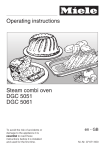Download Miele DG 1050 Operating instructions
Transcript
Operating instructions Steam oven DG 1050 To avoid the risk of accidents or damage to the appliance it is essential to read these instructions before it is installed and used for the first time. GHirZ M.-Nr. 06 643 810 Contents Description of the appliance . . . . . . . . . . . . . . . . . . . . . . . . . . . . . . . . . . . . . . . . . 4 Front view. . . . . . . . . . . . . . . . . . . . . . . . . . . . . . . . . . . . . . . . . . . . . . . . . . . . . . . . . 4 Accessories supplied . . . . . . . . . . . . . . . . . . . . . . . . . . . . . . . . . . . . . . . . . . . . . . . 5 Optional accessories . . . . . . . . . . . . . . . . . . . . . . . . . . . . . . . . . . . . . . . . . . . . . . . . 6 Warning and Safety instructions . . . . . . . . . . . . . . . . . . . . . . . . . . . . . . . . . . . . . 8 Caring for the environment . . . . . . . . . . . . . . . . . . . . . . . . . . . . . . . . . . . . . . . . . 13 Before using for the first time . . . . . . . . . . . . . . . . . . . . . . . . . . . . . . . . . . . . . . . 14 Setting the water hardness . . . . . . . . . . . . . . . . . . . . . . . . . . . . . . . . . . . . . . . . . . 14 Cleaning and heating up for the first time . . . . . . . . . . . . . . . . . . . . . . . . . . . . . . . 15 Operation . . . . . . . . . . . . . . . . . . . . . . . . . . . . . . . . . . . . . . . . . . . . . . . . . . . . . . . 16 Before each use. . . . . . . . . . . . . . . . . . . . . . . . . . . . . . . . . . . . . . . . . . . . . . . . . . . 16 Operating sequence . . . . . . . . . . . . . . . . . . . . . . . . . . . . . . . . . . . . . . . . . . . . . . . 16 Switching on and setting a temperature . . . . . . . . . . . . . . . . . . . . . . . . . . . . . . . . 17 Setting a cooking duration . . . . . . . . . . . . . . . . . . . . . . . . . . . . . . . . . . . . . . . . . . . 18 After starting a programme . . . . . . . . . . . . . . . . . . . . . . . . . . . . . . . . . . . . . . . . . . 19 Interrupting a programme . . . . . . . . . . . . . . . . . . . . . . . . . . . . . . . . . . . . . . . . . . . 19 At the end of the cooking duration . . . . . . . . . . . . . . . . . . . . . . . . . . . . . . . . . . . . 20 After use. . . . . . . . . . . . . . . . . . . . . . . . . . . . . . . . . . . . . . . . . . . . . . . . . . . . . . . . . 20 Insufficient water . . . . . . . . . . . . . . . . . . . . . . . . . . . . . . . . . . . . . . . . . . . . . . . . . . 20 Practical tips. . . . . . . . . . . . . . . . . . . . . . . . . . . . . . . . . . . . . . . . . . . . . . . . . . . . . 21 Suitable containers . . . . . . . . . . . . . . . . . . . . . . . . . . . . . . . . . . . . . . . . . . . . . . . . 21 Steaming . . . . . . . . . . . . . . . . . . . . . . . . . . . . . . . . . . . . . . . . . . . . . . . . . . . . . . . . 23 Reheating. . . . . . . . . . . . . . . . . . . . . . . . . . . . . . . . . . . . . . . . . . . . . . . . . . . . . . . . 27 Defrosting. . . . . . . . . . . . . . . . . . . . . . . . . . . . . . . . . . . . . . . . . . . . . . . . . . . . . . . . 28 Bottling . . . . . . . . . . . . . . . . . . . . . . . . . . . . . . . . . . . . . . . . . . . . . . . . . . . . . . . . . . 30 Cooking whole meals. . . . . . . . . . . . . . . . . . . . . . . . . . . . . . . . . . . . . . . . . . . . . . . 31 Blanching . . . . . . . . . . . . . . . . . . . . . . . . . . . . . . . . . . . . . . . . . . . . . . . . . . . . . . . . 32 Preparing yoghurt . . . . . . . . . . . . . . . . . . . . . . . . . . . . . . . . . . . . . . . . . . . . . . . . . 32 Disinfecting baby bottles . . . . . . . . . . . . . . . . . . . . . . . . . . . . . . . . . . . . . . . . . . . . 33 2 Contents Cleaning and care . . . . . . . . . . . . . . . . . . . . . . . . . . . . . . . . . . . . . . . . . . . . . . . . 34 General notes . . . . . . . . . . . . . . . . . . . . . . . . . . . . . . . . . . . . . . . . . . . . . . . . . . . . 34 Appliance front and housing . . . . . . . . . . . . . . . . . . . . . . . . . . . . . . . . . . . . . . . . . 34 Oven interior . . . . . . . . . . . . . . . . . . . . . . . . . . . . . . . . . . . . . . . . . . . . . . . . . . . . . 35 Condensate tray, rack and cooking containers . . . . . . . . . . . . . . . . . . . . . . . . . . . 35 Water container . . . . . . . . . . . . . . . . . . . . . . . . . . . . . . . . . . . . . . . . . . . . . . . . . . . 36 Coupling seal . . . . . . . . . . . . . . . . . . . . . . . . . . . . . . . . . . . . . . . . . . . . . . . . . . . . 37 Descaling . . . . . . . . . . . . . . . . . . . . . . . . . . . . . . . . . . . . . . . . . . . . . . . . . . . . . . . . 38 Programming . . . . . . . . . . . . . . . . . . . . . . . . . . . . . . . . . . . . . . . . . . . . . . . . . . . . 40 Problem solving guide. . . . . . . . . . . . . . . . . . . . . . . . . . . . . . . . . . . . . . . . . . . . . 41 After sales service, data plate. . . . . . . . . . . . . . . . . . . . . . . . . . . . . . . . . . . . . . . 43 Electrical connection . . . . . . . . . . . . . . . . . . . . . . . . . . . . . . . . . . . . . . . . . . . . . . 44 Technical data . . . . . . . . . . . . . . . . . . . . . . . . . . . . . . . . . . . . . . . . . . . . . . . . . . . 46 3 Description of the appliance Front view a Display with symbols for: p Insufficient water k Descale °C Temperature h Duration b Function selector c Ventilation outlet d Door seal e Steam channel f Compartment for water container g Water container (with insert) 4 h Contact point i Side runners j Steam inlet k Floor heater l Temperature sensor m Outlet for air from oven interior n Drip channel in the door o Door release Description of the appliance Accessories supplied Additional accessories can be ordered at extra cost. See back page for contact details. Condensate tray (gross capacity 2.0 litres/ usable capacity 1.7 litres) To catch excess moisture Gastronorm size GN 1/2 325x265x40 mm (WxDxH) 2 cooking containers DGGL 1, perforated (gross capacity 1.5 litres / usable capacity 0.9 litres) For steaming Gastronorm size GN 1/3 325x175x40 mm (WxDxH) Rack Miele steam oven cookbook For placing cooking containers on A selection of the best recipes from the Miele test kitchen. Silicone grease For lubricating the coupling seal Please read the relevant instructions in "Cleaning and care". 5 Description of the appliance Optional accessories Stainless steel containers Gross / usable capacity in litres Height in mm Width x Depth in mm 2.5 / 2.0 65 325 x 175 4.0 / 3.1 65 325 x 265 For steaming vegetables, fish DGGL 4 perforated and meat which is not being cooked in a sauce (GN 1/2) 4.0 / 3.1 65 325 x 265 For cooking vegetables, fish, DGGL 5 perforated meat and potatoes (GN 1/3) 2. 5 / 2.0 65 325 x 175 For blanching or cooking DGGL 6 perforated vegetables (GN 1/3) 4.0 / 2.8 100 325 x 175 4.0 / 2.8 100 325 x 175 2.0 / 1.7 40 325 x 265 - - - Description Use DGG 2 solid (GN 1/3)* For dishes in sauces and for cooking dried foods like pasta and rice in liquid DGG 3 solid (GN 1/2) as DGG 2, but deeper DGG 7 solid (GN 1/3) For cooking a medium sized quantity of soup or a medium sized casserole as DGG 4, DGGL 8 perforated but shallower (GN 1/2) DGD Lid for solid cooking containers DGG 2 and DGG 7 * Gastro-Norm sizes (Example GN 1/3) 1/3 or 1/2 is the width and depth of the cooking containers given as shown below. 6 Description of the appliance Other accessories Description Use Miele descaling tablets (6 tablets) For descaling Miele steam ovens and coffee machines Neoblank stainless steel To help prevent re-soiling, water marks conditioning agent and finger prints on stainless steel 250 ml surfaces. Miele ceramic hob cleaner 250 ml For removing discolouration on the floor heater caused by drops of liquid Microfibre "E-Cloth" (Miele UK only) For cleaning surfaces such as stainless steel, glass, plastic and chrome without the use of chemicals Contact details: Miele accessories are available from - your Miele dealer or - the Miele Spare Parts Department (see back cover for contact details). 7 Warning and Safety instructions To avoid the risk of accidents to the appliance please read these instructions carefully before using it for the first time. They contain important information on its installation, safety, use and maintenance. The use of the appliance by the elderly or infirm or those who have not used the appliance before should be supervised by a competent and responsible person to avoid the risk of injury. Please stick the extra data plate for the appliance supplied with this documentation in the space provided in the "After sales service" section of this booklet. Keep these instructions in a safe place and pass them on to any future user. Technical safety Before connecting the appliance to the mains supply make sure that the connection data on the data plate (voltage and connected load) match the mains electricity supply. If in any doubt, consult a qualified electrician. 8 The electrical safety of this appliance can only be guaranteed when continuity is complete between it and an effective earthing system which complies with local and national safety regulations. It is most important that this basic safety requirement is present and regularly tested and where there is any doubt, the household wiring system should be inspected by a qualified electrician. The manufacturer cannot be held liable for the consequences of an inadequate earthing system (e.g. electric shock). Do not connect the appliance to the mains electricity supply by an extension lead. Extension leads do not guarantee the required safety of the appliance (e.g. danger of overheating). Never open the casing of the appliance. Tampering with electrical connections or components is highly dangerous to the user and can cause operational faults. Do not use the appliance if the cable is damaged in any way. If the connection cable is faulty it must only be replaced by a Miele approved service technician to protect the user from danger. Warning and Safety instructions Correct usage This appliance is intended for domestic use only and is not to be used for commercial purposes. This appliance must only be used as described in these instructions. Any other usage is at the owner's risk and could be dangerous. The manufacturer cannot be held liable for damage resulting from incorrect or improper use of the appliance. Do not immerse the water container in water, or clean it in a dishwasher. Connecting the water container into the appliance when wet could cause an electric shock. For reasons of hygiene and to prevent the build-up of moisture in the appliance, the water container should be emptied after each use. The drip channel should be wiped dry with a soft cloth after each use. Leave the door open until the cooking compartment is completely dry. If the appliance is not going to be used for a longer period of time, e.g. whilst on holiday, it should be thoroughly cleaned beforehand to prevent the build-up of odours etc. Refer to "Cleaning and heating up for the first time" and carry out the procedure as described. Leave the door open afterwards. 9 Warning and Safety instructions Safety with children The appliance must be installed at such a height that small children cannot reach the appliance door, which gets hot during use. The appliance is only intended for use by adults who have read these instructions. This appliance is not a toy! To avoid the risk of injury, keep children well away and do not let them play with it or use the controls. They will not understand the potential dangers posed by it. They should be supervised whenever you are working in the kitchen. The appliance gets hot when in use and remains hot for quite a while after being switched off. To safeguard against burning, keep children well away from the appliance at all times. Warning: Take care in the area around the hinges. Danger of injury. Keep children well away. Do not allow children to swing on the open oven door. 10 Packaging (e.g. cling film, polystyrene) and plastic wrappings must be kept out of the reach of babies and young children. Danger of suffocation. Dispose of or recycle all packaging safely as soon as possible. Before discarding an old appliance, switch off and disconnect it from the power supply. Cut off and render any plug useless. Cut off the cable directly behind the appliance to prevent misuse. This should be done by a competent person. See "Disposal of your old appliance" for further details. Warning and Safety instructions Protecting the appliance from damage Do not use the appliance to heat up food in sealed jars and tins. Pressure will build up inside them, and they can explode causing damage to the appliance, as well as the risk of injury and scalding. Do not store cooked food in the oven. The moisture in the food can lead to corrosion in the appliance. Do not use metallic containers or utensils in the oven which are likely to rust. This can cause corrosion. Only use the descaling tablets supplied or a proprietary citric acid descaling agent to descale the appliance (see "Optional accessories"). Follow the manufacturer's instructions on the packaging. Do not use vinegar or descaling agents containing vinegar, as these can cause corrosion in the appliance. Do not use a steam cleaner to clean this appliance. The steam could reach electrical components and cause a short circuit. Pressurised steam could also cause permanent damage to the surface and to other components, for which the manufacturer cannot accept liability. The appliance is designed in such a way that there will always be a little residual water left in the water container after use. If there is no residual water, there is something wrong. Call the Service Department. Protection from burning The appliance must be positioned so that you can see the contents of a cooking container placed on the top runner. Otherwise you may risk scalding or burning yourself with hot water and food when taking containers out of the oven. The appliance, especially the inside of the door and the area around the ventilation outlet, becomes extremely hot during use, and remains hot for some time after switching off. If the oven is still hot, steam will escape when the door is opened. Stand back away from the appliance and wait until the steam has dissipated. Take care when opening the door not to spill any hot water that has collected in the drip channel. To protect your hands, use oven gloves when using the appliance. However, do not let them get damp or wet, as this causes heat to transfer through the material more quickly with the risk of burning yourself. When putting cooking containers or the condensate tray into the oven or taking them out, take care not to spill the contents. Avoid contact with hot steam, and do not touch the hot oven interior walls. Danger of burning and scalding. Take care not to tip the water container when taking it out of the appliance. Hot water can scald. 11 Warning and Safety instructions Appliance faults Further safety notes If there is any damage to the appliance, it must be switched off and disconnected from the mains electricity supply immediately.It must not be used again until it has been repaired. Switch off at the socket and withdraw the plug. Contact the Service Department. Do not reconnect the appliance to the mains electricity supply until after it has been repaired. When using an electric socket near the appliance, care should be taken that the cable of the appliance cannot get trapped by the appliance door. The insulation on the cable could become damaged, giving rise to an electric shock hazard. Repairs should only be carried out by a suitably qualified and trained person in accordance with local and national safety regulations. Repairs and other work by unqualified persons could be very dangerous and could damage the appliance. The manufacturer cannot be held liable for unauthorised work. Never open the housing of the appliance. While the appliance is under guarantee, repairs should only be undertaken by a service technician authorised by the manufacturer. Otherwise the guarantee is invalidated. Always ensure that food is sufficiently cooked or reheated. Some foods, e.g. poultry, may contain micro-organisms which are only destroyed by thorough cooking at a sufficiently high temperature for long enough. If in doubt select a longer cooking or reheating time. When the door is open be careful not to hurt yourself on edges and corners, and especially on the door catches. If using plastic cooking containers, make sure that they are heat- and steam-resistant to 100 °C. Otherwise they may melt, distort or break. In countries where there are areas which may be subject to infestation by cockroaches or other vermin, pay particular attention to keeping the appliance and its surroundings in a clean condition at all times. Any damage caused by cockroaches or other vermin will not be covered by the guarantee. The manufacturer cannot be held liable for damage caused by non-compliance with these Warning and Safety instructions. 12 Caring for the environment Disposal of the packing material The transport and protective packing has been selected from materials which are environmentally friendly for disposal and can normally be recycled. Packaging, e.g. cling film, polystyrene and plastic wrappings, must be kept out of the reach of babies and young children. Danger of suffocation. Disposal of your old appliance Electrical and electronic appliances often contain materials which, if handled or disposed of incorrectly, could be potentially hazardous to human health and to the environment. They are, however, essential for the correct functioning of your appliance. Please do not therefore dispose of your old appliance with your household waste. Dispose of or recycle all packaging materials safely as soon as possible. Please dispose of it at your local community waste collection / recycling centre and ensure that it presents no danger to children while being stored for disposal. It should be unplugged or disconnected from the mains electricity supply by a competent person. If connected by a plug, the plug must be rendered useless and the cable cut off directly behind the appliance to prevent misuse. 13 Before using for the first time Setting the water hardness "P 1" will appear in the display. The steam oven is set at the factory to water hardness setting IV (Very hard 4). If your water hardness level differs from this, you will need to re-programme the appliance. You can use the test strip supplied to check the water hardness level, or your local water supplier will be able to advise you on the water hardness of your area. The water hardness is shown as settings I to IV equivalent to the German scale 1 to >21 °dH (0.2 - 3.8 mmol/l). Hardness setting Display Hardness range I (soft) 1 1-7 °dH (0.2 - 1.3 mmol/l) II (medium) 2 8-14 °dH (1.4 - 2.5 mmol/l) III (hard) 3 15-21 °dH (2.7 - 3.8 mmol/l) IV (very hard) 4 >21 °dH (above 3.8 mmol/l) Proceed as follows: Before you begin, ensure that the appliance is switched off. ^ Press the function selector in and turn it anti-clockwise slightly. ^ Then release the function selector. 14 ^ Turn the function selector until "P 3" appears in the display. ^ Confirm your selection by pressing the function selector. A "4" and the k symbol will appear in the display. ^ Turn the function selector until the water hardness level you want appears in the display, e.g. "3" for hard. ^ Confirm your selection by pressing the function selector. "P 3" will appear in the display. ^ Press the function selector until the display goes out. Before using for the first time Cleaning and heating up for the first time Open the door by pressing on the left hand side of the door release. The door will open slightly. Take the water container out of the appliance and remove the insert (see "Cleaning and care"). Rinse the water container and the insert thoroughly by hand using hot water. Do not use any washing-up liquid or detergent. Do not clean the water container or the insert in a dishwasher. Do not immerse the water container in water. Now fill the water container with mains tap water (see "Before each use") and then run the appliance for 15 minutes at 100°C. Proceed as described in "Operation". This process flushes out the waterways and sets the appliance for the altitude in your area. If you move house, the appliance will need to be re-set for the new altitude if this differs from the old one by more than 300 m. To do this, descale the appliance (see "Cleaning and care"). Warning! A lot of steam will be emitted from the appliance the first time it is used, and the first time it is descaled after moving house. 15 Operation Before each use Operating sequence ^ When using a perforated cooking container, place the condensate tray on the floor of the oven to catch any drips. To make a selection you turn the function selector, and to confirm your selection you press it. ^ Fill the water container. You do not need to remove the insert. Only use mains tap water. Never use distilled or mineral water. The water level must be between the two markings (min. 0.75 l and max. 1.2 l). These are located inside and outside the container. On no account exceed the upper or maximum level marker. Add water as required. Using hot water will shorten the heating-up time. ^ Use both hands to carry the water container. Take care not to let any water spill out. Push the water container into the appliance until it connects. If the water container is not positioned correctly, the appliance will not heat up and after a while F20 will appear in the display (see "Problem solving guide"). 16 A Switch the appliance on by pressing the function selector. B Confirm the temperature or change it and then confirm the change. C Select and confirm a cooking duration. The steam oven starts automatically. If you do not complete these steps within 15 minutes, the appliance will switch itself off. They are described in more detail on the following pages. Operation Switching on and setting a temperature ^ Switch the appliance on by pressing the function selector briefly. "100°C" will appear in the display. "°C" will start flashing. Recommended temperature 100 °C: For cooking food which can be cooked at higher temperatures, such as meat, vegetables, casseroles, soup and bakes. Also suitable for reheating food. 85 °C: For gently cooking more delicate food such as fish. 60 °C: For defrosting. The temperature can be set in 5 °C steps in a range from 40 °C to 100 °C. See "Practical tips" and the cookbook for more cooking tips. ^ Turn the function selector to set the temperature you want. ^ Confirm your selection by pressing the function selector. You can alter the temperature at any time during operation. Press the function selector once briefly. The display will change to the temperature setting display and "°C" will flash. Set the temperature as described earlier. 17 Operation Setting a cooking duration After confirming the temperature, 3 zeros will appear in display and "h" will start flashing. ^ Set the required duration, e.g. 20 minutes, by turning the function selector. A duration of between 1 minute (0:01) and 4 hours 59 minutes (4:59) can be set. ^ Confirm your selection by pressing the function selector. You can alter the cooking duration at any time during operation. Press the function selector twice. The display will change to the cooking duration setting display and "h" will flash. Set the cooking duration as described earlier. 18 The charts later in these operating instructions and the cookery book give suggested cooking durations for various types of food. Remember that the cooking duration is not dependent on the amount of food, but on the size of the food. For example, large potatoes will take longer to cook than smaller potatoes. To achieve good results using the durations quoted, please do not cook quantities of food for more than 6-8 servings. Cooking durations will also vary depending on the cooking container used (see "Suitable containers"). Operation After starting a programme The appliance will start automatically after you have confirmed your selection of the cooking duration. At first you will hear the fan and then some other noises from the steam generating unit. During the Heating up phase the display will show the current temperature in the cooking compartment. You can follow the rising temperature of the cooking compartment in the temperature display. When preparing food which has been refrigerated or frozen, the temperature in the cooking compartment will fall initially before starting to rise gradually. When the set temperature is reached, the display will change to show the cooking duration. The cooking phase begins and the duration will start counting down. and the initial temperature of the food being cooked. Interrupting a programme You can interrupt a programme at any time by opening the door. The heating will be switched off and the cooking duration remaining stored in memory. Steam will escape when the door is opened. Step back from the appliance and wait until the steam has dissipated. When opening the appliance, take great care that hot water which may have collected in the drip channel in the door does not overflow. Also when putting the condensate tray or cooking containers into the oven or taking them out, take care not to spill the contents. Do not come into contact with hot steam and do not touch the hot oven sides. Danger of burning and scalding. You can continue the programme by closing the door. Please note that the total duration, i.e. the time between the beginning and end of a programme, is made up of the heating-up time and the set cooking duration added together. The heating up time and therefore also the total duration will depend on the quantity The oven will heat up again and the display will show the rising temperature of the cooking compartment. Once the set temperature has been reached, the display will change to show the cooking duration remaining as it counts down. 19 Operation At the end of the cooking duration At the end of the set cooking duration, an audible tone will sound, 3 zeros will appear and "h" will flash in the display. ^ Switch the appliance off by pressing the function selector. The fan will continue to run for a while after the oven has been switched off. If you want to reduce the run-on time, you can do so by removing the water container as soon as you have switched the appliance off. Steam will escape when the door is opened. Step back from the appliance and wait until the steam has dissipated. When opening the appliance, take great care that hot water which may have collected in the drip channel in the door does not overflow. Also when taking the condensate tray or cooking containers out of the oven, take care not to spill the contents. Do not come into contact with hot steam and do not touch the hot oven sides. Danger of burning and scalding. After use ^ Remove the condensate tray and empty it. ^ Remove the water container and empty it. Push the water container upwards slightly when removing it from the appliance. ^ After each use, clean and dry the whole appliance as described in "Cleaning and care". ^ Leave the door open until the cooking compartment is completely dry. The appliance is designed in such a way that there will always be a little residual water left in the water container after use. If there is no residual water, there is something wrong. Call the Service Department. Insufficient water Insufficient water is indicated in the display by the flashing p symbol. An audible tone will also sound during operation. ^ Check the water level and add water if necessary. ^ Push the water container into the appliance until it connects. ^ Close the door. You can now use the oven as normal. 20 Practical tips Suitable containers Some stainless steel cooking containers are supplied with the appliance. Other containers, in a variety of sizes, both perforated and solid, are available as optional extras. When choosing the most suitable container for the particular food you are cooking, please note: – Use perforated cooking containers whenever possible, e.g. for cooking vegetables. The steam can reach the food from all sides and the food is cooked evenly. – With large items of food, such as whole potatoes, the steam can work effectively because there are spaces between the individual pieces into which the steam can penetrate.This way a large quantity will take the same time to cook as a smaller amount and large, deep containers can be used. Where possible space the food out to allow the steam more room. – More compact dishes such as casseroles or bakes, or food such as peas or asparagus spears, which have little or no space between them will take longer to cook because the steam has less space to work in. The fuller the container, the longer it will take to cook. It is best to use 2 or 3 shallow containers rather than one deep one for these types of foods, and then fill them only 3-5 cm deep. Cooking times quoted are calculated on this principle. Deeper dishes will take longer to cook. – To ensure even results when cooking with more than one container, do not use more than one gastronorm size GN 1/2 container. – The steam oven is designed to cook quantities of up to 6-8 portions. Be careful not to exceed the amounts quoted. You will find various tips on how to use the steam oven in the following sections or in the cook book. 21 Practical tips Heat-resistant glass, ceramic, porcelain, plastic, stainless steel and enamel dishes are all suitable. Important: – If using plastic cooking containers, make sure that they are heat-resistant to 100 °C and able to withstand hot steam. – Food will take considerably longer to cook than the time quoted if the dish has thick sides. 22 – Place the container on the rack supplied. – Ensure that there is a gap of at least 3 cm between the upper rim of the container and the top of the cooking compartment to allow sufficient steam into the container. Practical tips Steaming Food Temperature in °C Duration in minutes al dente well done Vegetables Asparagus, green 100 3-5 6-8 Baby Carrots (whole) 100 3-5 6-9 Beans (french) 100 3 4-5 Beans (runner, sliced) 100 2-3 4-5 Beetroot (whole) 100 - 20-30 Broccoli 100 4 5-7 Brussels sprouts 100 4-6 8-10 Cabbage (shredded) 100 4-6 8-10 Carrots (stick) 100 1-2 3-4 Cauliflower (florets) 100 2-3 5-7 Courgettes (sliced) 100 2 3 Fennel (quartered) 100 6-8 10-14 Leeks (sliced) 100 - 2-3 Mangetout 100 2 4 Mushrooms (whole) 100 - 3-4 Parsnips (halved) 100 2-4 6-8 Peas 100 2 4 Peppers (strips) 100 2-3 4-5 Potatoes (halved) 100 5-6 14-20 Potatoes, new (baby whole) 100 - 14-18 Spinach (fresh) 100 - 3-4 Sugar snap peas 100 2-3 4-5 Swede (diced) 100 1 4-6 Sweet potato 100 1 4-6 Sweetcorn (baby, whole) 100 2 6-8 Sweetcorn (whole cob) 100 8-10 20-24 23 Practical tips Food Temperature in °C Duration in minutes Beef goulash 100 40-50 Chicken breast 100 8-10 Chicken, whole 100 50-60 Knuckle of pork 100 90-95 Lamb ragout 100 12-16 Turkey escalope 100 4-6 Turkey roulade 100 12-15 Veal escalope 100 3-4 100 5-6 Meat Fish Cod steaks Salmon (fillets) 100 6-8 Trout (fillets) 100 3-6 Tuna steak 100 6-8 Mussels 90* 10-12 Plaice, fillet 85 5-7 Monk fish 85 8-10 Trout, 250 g 90* 10-12 Blanching vegetables 90* 1-2 Disinfecting baby bottles 100 15 Melting chocolate (use a cover) 90* 4-10 Miscellaneous 24 Practical tips Food Temperature in °C Duration in minutes 100 60-65 Chick peas 100 50-60 Millet 100 9-10 Pearl Barley 100 60-80 Buckwheat 100 20-24 Read split lentils (un-soaked) 100 10-15 Yellow split lentils (pre-soaked) 100 40 White basmati 100 8-10 Brown basmati 100 15-20 Long grain 100 10-12 Brown 100 12-16 Wild 100 50-60 Thai fragrant / Jasmine 100 10-12 Risotto / Arborio 100 16-20 Mixed basmati and wild rice 100 20 Soft boiled 100 3-4 Medium boiled 100 5-6 Hard boiled 100 8-10 Cooking apples (sliced) 100 1-2 Apples (sauce) 100 4-6 Peaches (halved) 100 4-6 Dried beans and pulses Red kidney beans (pre-soaked) Rice Eggs Fruit 25 Practical tips Tips on steaming – In general, the cooking durations for cooking with steam are the same as for cooking food in a saucepan. – Steam prevents food from drying out so it remains moist, and juices are not lost. This applies to a wide variety of food, including dumplings, steam puddings, fish and meat dishes, as well as vegetables. – You can select any shelf level. You can also cook on several levels at the same time. This will not alter the cooking duration. – Food does not brown or get crisp from over-cooking. It is gently steamed, and not roasted or baked. Cheese melts perfectly without getting burnt. It is a healthy way of cooking, and it brings out the distinct flavour of the food. – When cooking frozen food, e.g. vegetables, ensure that any large clumps frozen together are broken up first so that they cook evenly. The cooking duration is approximately the same as for fresh vegetables. – Frozen and fresh vegetables which take the same length of time to cook can be cooked together. – Cooking with steam retains the true taste of the food better than conventional cooking. Therefore food should not be seasoned until after it has been cooked. – Only fill solid containers 3/4 full with liquid. 26 – Dried foods like pasta and rice must be cooked in liquid. Pasta should be well covered with liquid. With rice, pulses etc. the proportion of food to liquid should be 1:1. – When cooking noodles, follow the manufacturer's instructions on the packaging regarding cooking duration. – Cooking liquids do not boil away. They are either absorbed by the food, as with rice and pasta, or they remain in the dish to form a sauce, as with casseroles. The sauce can then be thickened or added to after cooking. – You can thicken sauces in the steam oven by adding flour and butter to liquid (40 g flour and 40 g butter to 0.5 litres liquid). – Grease perforated containers beforehand if using them to cook fish, and solid containers if using to cook dishes containing eggs. – To avoid any transfer of tastes caused by moisture dripping down from above, solid containers should be placed above perforated containers. – Yeast dough can be put in the oven to rise. Cover the dough. Practical tips Reheating Food to be reheated Duration in minutes Your steam oven is very effective at reheating dishes which have been prepared previously. Proceed as follows: Vegetables Cauliflower, runner beans 2 Carrots, kohlrabi 2 Side dishes ^ Place the food on a flat plate and cover it with a deeper plate or some heat-resistant foil. Dumplings, potatoes (halved) 3-4 ^ Select and confirm a temperature of 100 °C. Pasta, rice 2-3 ^ Set the duration (see chart). Meat and poultry Sliced meat 1.5 cm thick 3-5 Stew 3-5 Chicken schnitzel 3-5 Meatballs in sauce 3-5 Sliced roulade 3-5 Useful tip: If sauces are to be served separately, reheat them in a covered dish on their own. Fish Fish fillet 2-3 Fish roulade, halved 2-3 Plated meals Chicken fricassee with rice 3-5 Roast pork with potatoes and vegetables 3-4 Spaghetti with tomato sauce 2-3 Soups/casseroles Casseroles 4-5 Soup 2-3 27 Practical tips Defrosting Food to be defrosted Weight in g Temp. in °C Defrosting duration in minutes Standing time in minutes 500 60 30-40 10-15 Meat Stew Minced meat 250 50 15-20 10-15 Cutlets, chops, sausages 800 60 25-35 15-20 Chicken 1000 60 40 15-20 Chicken drumsticks 150 60 20-25 10-15 Chicken schnitzel 500 60 25-30 10-15 Fish fillets 400 60 15 10-15 Prawns 300 60 4-6 5 Frozen in a block 300 60 20-25 10-15 Frozen in small portions 350 60 15 8-10 Apple sauce/stewed apples 250 60 20-25 10-15 Strawberries/raspberries 300 60 8-10 10-12 Poultry Fish, seafood Vegetables Fruit Dairy products Cheese 100 60 15 10-15 Cream 250 60 20-25 10-15 - 60 10-12 10-15 Baking Puff pastries Yeast buns Bread Bread rolls 28 - 60 10-12 10-15 250 100 10-15 10-15 - 100 6-7 1-2 Practical tips Frozen food can be defrosted in this appliance in much less time than when defrosting at room temperature. Proceed as follows: ^ Place the food in a suitable container or on the rack. ^ Select the temperature (see chart). ^ Select the defrost duration (see chart). Tips on defrosting – All meat and poultry should be fully defrosted before cooking. When defrosting meat or poultry place the condensate tray underneath the rack to catch the defrosted liquid, so that the meat is not lying in this liquid. It is particularly important to observe food hygiene rules when defrosting poultry. Do not use the liquid from defrosted poultry. Pour it away and wash the tray, the sink and your hands. Danger of salmonella poisoning! – Fish does not need to be fully defrosted before cooking. Defrost so that the surface is sufficiently thawed to take herbs and seasoning. – When defrosting food which has frozen together, e.g. berries, chops, fish fillets etc separate or break it up about half-way through the defrosting time. – Allow food to stand at room temperature at the end of defrosting. This standing time (see chart) is necessary to ensure that the food is fully defrosted right through to the core. – Do not refreeze food once it has thawed. – Defrost frozen pre-cooked meals according to the manufacturer's instructions. – Defrost baked goods in a sealed freezer bag. – Food which does not drip can be placed on the rack or in a dish once the wrapping has been removed. 29 Practical tips Bottling Produce Proceed as follows: Temp. in °C Duration in minutes* Apples 90 50 Apple sauce/stewed apples 90 65 Red / Blackcurrants 80 50 Gooseberries 80 55 Fruit with stones 85 55 Obst ^ Place a maximum of 4 prepared jars (all the same size) on the rack, ensuring that they do not touch one another. This allows the hot steam to surround the jars on all sides. ^ Select the temperature (see chart). ^ Set the duration (see chart). ^ Make use of residual heat by leaving the jars in the oven for 30 minutes after it has switched off. ^ Cover the jars with a cloth and allow to cool for approx. 24 hours. Vegetables Beans 100 120 Gherkins 90 55 * The durations quoted are for 1.0 litre jars. If using 0.5 litre jars reduce the duration by about 15 minutes. If using 0.25 litre jars reduce the duration by about 20 minutes. 30 ^ Place the condensate tray on the floor of the cooking compartment and place the rack on top of the condensate tray. Practical tips Cooking whole meals It is very economical and practical to cook a whole meal at the same time in the steam oven. Proceed as follows: ^ Place cooking containers on different levels or place them side by side or one on top of the other on the rack. In general, cooking durations will vary according to the type of food. This means that you will need to open the steam oven at different times to add a particular dish. See example below: Rice Fish fillet Broccoli 20 minutes 6 minutes 4 minutes ^ First place the dish with the longest cooking time, i.e. the rice, in the oven. ^ Select and confirm a temperature of 100 °C. ^ Calculate the initial cooking duration by subtracting the cooking duration for the fish from the duration for the rice, i.e. 20 minutes less 6 minutes = 14 minutes. ^ After 14 minutes, place the fish in the oven. ^ To calculate the next cooking duration subtract the time for the broccoli from the time for the fish: 6 - 4 = 2. Set a duration of 2 minutes and confirm your selection. ^ After 2 minutes, place the third dish (broccoli) in the oven. ^ Set the cooking duration for the broccoli, 4 minutes and confirm your selection. At the end of the cooking duration you can remove all three dishes at the same time. 31 Practical tips Blanching Preparing yoghurt You can use your steam oven to blanch vegetables and fruit for freezing. Proceed as follows: Proceed as follows: ^ Put the prepared vegetables/fruit (cleaned, washed, chopped etc.) into a perforated cooking container. ^ Select and confirm a temperature of 100 °C. ^ Set and confirm a duration of 1 minute. ^ Once blanched, plunge the vegetables/fruit into ice cold water to cool them down quickly. Drain them well. The vegetables/fruit can now be frozen. ^ Mix 100 g yoghurt (with live culture) with 1 litre of fresh milk. The yoghurt and milk should have the same percentage fat content. If using unpasteurised milk you will need to heat it up to 90 °C (do not boil) and then leave it to cool. Otherwise the yoghurt will not set. ^ Pour this milk mixture into 6 or 7 portion sized glass dishes and cover with heat resistant cling film. Special yoghurt jars may also be used. ^ Place the covered dishes on the rack. ^ Reduce the temperature to 40 °C and confirm your selection. ^ Set a maximum duration of 4 hours and 59 minutes. ^ Allow the yoghurt to cool and then place in the refrigerator. It will not achieve its maximum set until it has been thoroughly chilled. 32 Practical tips Disinfecting baby bottles Proceed as follows: The steam oven can be used to disinfect baby bottles and other containers. Check beforehand that all parts, teats etc., are declared by the manufacturer to be heat-resistant to 100 °C. ^ Place the condensate tray on the floor of the cooking compartment and place the rack on top of the condensate tray. ^ Dismantle, clean and thoroughly rinse the bottles and space the individual parts out on the rack, ensuring that they do not touch one another. This allows the hot steam to reach them from all sides. ^ Select and confirm a temperature of 100 °C. ^ Set and confirm a duration of at least 15 minutes. ^ Dry thoroughly using a fresh, clean tea towel after disinfection. All parts of the bottles must be completely dry before they are reassembled to keep them germ free. 33 Cleaning and care General notes Appliance front and housing Clean the whole appliance and then dry it thoroughly after each use. Allow the appliance to cool down to a safe temperature before cleaning. The appliance front and controls and the housing can be cleaned using a Miele E-Cloth (see "Optional accessories") or a mild solution of hot water with a little washing up liquid, applied with a damp cloth. Wipe the surfaces dry using a soft cloth. Make sure the appliance is completely dry before closing the door. Do not use a steam cleaner to clean this appliance. The steam could reach electrical components and cause a short circuit. Pressurised steam could also cause permanent damage to the surface and to components, for which the manufacturer cannot accept liability. Never use cleaners containing alkalines, soda, acids or chlorides, oven sprays, dishwasher detergents or abrasive cleaning agents, hard brushes, scouring pads and cloths or steel wool. You should also avoid using sponges etc. which have previously been used with abrasive cleaning agents, as these would damage the surface. Do not use commercial cleaning agents. Only use agents designed for domestic use. Do not use cleaning agents or washing up liquids containing aliphatics as these could cause the seals to swell. 34 For appliances with glass fronts, a proprietary glass cleaning agent may be used. For stainless steel surfaces, we recommend using a non-abrasive proprietary cleaning agent for stainless steel. To help prevent marks, you could also use a conditioning agent for stainless steel (see "Optional accessories"). Follow the manufacturer's instructions on the label, and apply sparingly with an even pressure following the direction of the grain. Cleaning and care Oven interior Dry the oven interior, oven interior roof, door seal, drip channel, inside of the door and the compartment for the water container after each use. Use a sponge or absorbent cloth to wipe off the condensate which has built up. Condensate tray, rack and cooking containers The condensate tray, rack and cooking containers should be washed and dried each time they are used. They are all dishwasher safe. Remove grease deposits with a mild solution of washing up liquid and warm water and wipe with clean water. Over time, the floor heater can become discoloured by drops of liquid. This discolouration is easy to remove with a proprietary cleaner for ceramic surfaces. Follow the manufacturer's instructions. After cleaning, wipe the surface with a damp cloth to remove any cleaning agent residues. The door seal can become porous and brittle over time. If this is the case, it should be replaced with a new seal. Door seals can be ordered from the Miele Spare Parts Department. See back page for contact details. 35 Cleaning and care Water container Remove, empty and dry the water container after each use. Also remove the insert from the water container. ^ Release the insert by pushing the catches on the sides in towards each other and then pull it out of the container. ^ After cleaning, dry both parts of the insert thoroughly before replacing it in the water container. When replacing the insert (see illustration), guide it in at an angle a and push it downwards b. b a Do not immerse the water container in water or clean it in a dishwasher. It is important to empty the water container after each use for hygiene reasons, and also to prevent condensate building up in the appliance. Do not use scouring pads or hard brushes. 36 Cleaning and care Coupling seal The coupling seal should be replaced with a new one if it becomes brittle or porous over time or if an unusually large amount of water collects on the floor of the water container compartment. Replacement seals can be ordered from the Miele Spare Parts Department. See back page for contact details. The coupling seal needs to be lubricated regularly. If the water container becomes difficult to remove and replace or the fault message F20 appears, rub a small amount of the silicone grease supplied (see "Accessories supplied") into the inside of the coupling seal. When doing this, do not detach the seal but leave it in place. Only use the silicone grease supplied. On no account must margarine or oil or any other domestic grease or fat be used, as these can cause the seal to swell. When handling silicone grease, please observe the following safety measures: – Remove any silicone grease from your skin either by wiping it off or by washing it off. – If the grease gets into the eyes it must be rinsed out with plenty of clean water. – If it is swallowed, seek medical advice. 37 Cleaning and care Descaling Use the descaling tablets supplied or a proprietary citric acid descaling agent to descale the appliance (see "Optional accessories"). Follow the manufacturer's instructions on the packaging. Do not use vinegar or descaling agents containing vinegar, as these can cause corrosion in the appliance. The water container will need descaling after a certain number of operating hours. The display will alert you when this needs done. After switching on, the descaling symbol k and the number 10 will appear in the display. An audible tone will sound and "0:22 h" will appear in the display and the k symbol will start flashing. Proceed as follows: ^ Fill the water container with 1 litre of descaling solution. To make the solution, use cold water and descaling tablets, as instructed on the packet, or the appropriate amount of citric acid based household descaling agent. ^ Push the water container into the appliance until it connects. ^ Press the function selector. The number indicates that the appliance can be used a further 10 times before it locks out. If the appliance is not descaled immediately, a 9 will appear in the display the next time the appliance is switched on, and so on until it has been used ten times. The appliance will then lock and it must be descaled before it can be used again. You can start the descaling programme manually before the appliance locks out, by pressing the function selector for 4 seconds with the appliance switched off. 38 Descaling will now begin. The colon will flash and the k symbol will now light up constantly in the display. It is only possible to cancel the descaling process during the first few minute. After that the process cannot be cancelled. Important: Do not press the function selector during the descaling process. If it is pressed before the end of the process, the whole process will have to be started from the beginning again. Cleaning and care An audible tone will sound and the p symbol will start flashing ten minutes before the end of the descaling After descaling: An audible tone will sound when the descaling process has been completed. ^ Open the door. ^ Remove the water container and empty it. process. The water container needs to be filled with fresh water. ^ Switch the appliance off, and then dry it thoroughly. ^ Remove the water container and empty it out. Remove the insert. ^ Rinse the water container and the insert thoroughly. ^ Replace the insert and fill the water container with 1 litre of water. Push the water container into the appliance until it connects. ^ Now press the function selector to continue the descaling process. 39 Programming The standard settings listed in the chart can be altered. Several settings can be altered in succession. Programme P 1 Demo-mode P 2 Audible tone volume P 3 Water hardness Display Setting OFF the appliance will heat up ON the appliance will not heat up S1 to S4 The higher the number, the louder the audible tone 1 Soft 2 Medium 3 Hard 4 Very hard * The factory default settings are shown in bold. Proceed as follows: Before you begin, ensure that the appliance is switched off. ^ Press the function selector gently in and turn it anti-clockwise slightly. ^ Then release the function selector. "P1" will appear in the display. ^ Turn the function selector until the programme you want to alter appears. ^ Confirm your selection by pressing the function selector. 40 ^ Then turn the function selector until the setting you want appears. ^ Confirm your selection by pressing the function selector. ^ After you have altered the settings, press the function selector until the display goes out. Problem solving guide ... the appliance does not heat up. Installation work and repairs to electrical components of this appliance must only be carried out by a suitably qualified and competent person in accordance with current local and national safety regulations. Repairs and other work by unqualified persons could be dangerous. The manufacturer cannot be held liable for unauthorised work. What to do if, ... ... the fan can still be heard after the appliance has been switched off. The appliance is fitted with a fan which removes steam from the oven. The fan will continue to run for a while after the appliance has been switched off. ... you cannot switch the appliance on. Check that the appliance is switched on at the socket or whether the mains fuse has blown. If this is not the case, then disconnect the appliance from the electricity supply for approx. 1 minute. To do this: Check whether you set the demo mode setting by mistake (see "Programming"). ... the water container has become harder to put into the appliance and take out again. Lightly lubricate the coupling seal on the water container with silicone grease, as described in "Coupling seal". ... the heating up phase lasts an unusually long time. Check the bottom of the water container. If a thick layer of limescale has built-up, check the water hardness level that has been set. Set the correct water hardness level for your water supply (see "Setting the water hardness level"), and descale the appliance as described in "Descaling". If the water hardness level was in fact set correctly or the problem occurs again, contact the Service Department. – switch off at the wall socket and withdraw the plug or – withdraw the mains fuse. Reconnect to the mains supply and switch the appliance on. If it still will not start, contact a qualified electrician or the Miele Service Department. 41 Problem solving guide ... after moving house the appliance no longer switches from the heating up phase to the cooking phase. Altitude affects the boiling point of water. The appliance must be re-set to take into account the different water boiling point in its new location (see "Cleaning and heating up for the first time".) ... when the appliance is switched on, the k symbol and a number between 1 and 10 or "0:22h" appear in the display and the k symbol flashes. The appliance needs to be descaled. Proceed as described in "Descaling" in "Cleaning and care". ... F05 or F06 appears in the display. ... during operation an unusually large amount of steam escapes or steam escapes from parts of the steam oven where it does not usually. Check whether – the door is closed properly. – the door seal is fitted correctly. If necessary, press it in all the way round the door to make sure it is fitted evenly. – the door seal is damaged, e.g. cracks can be seen. The seal must be replaced with a new one. If this does not solve the problem, call the Miele Service Department. ... the p symbol appears in the display and an audible tone may sound. Check whether – the water container has been pushed right into the appliance so that it connects. – there is sufficient water in the water container. The water level must be between the two markings. 42 Switch the appliance off and call the Service Department. ... F20 appears in the display. The appliance does not heat up. – First of all, check whether the water container has been pushed right into the appliance so that it connects. Then switch the appliance off and then back on again. – If the fault occurs again, lightly lubricate the coupling seal on the water container with silicone grease, as described in "Coupling seal". If the appliance still will not start, switch it off and contact the Miele Service Department. ... after a period of time, the door makes a noise when it is opened and closed. Lubricate the hinges with the silicone grease supplied. After sales service, data plate In the event of any faults which you cannot remedy yourself, please contact: – your Miele dealer, or – the Miele Service Department (see address on back cover). When contacting your Dealer or the Service Department, please quote the model and serial number of your appliance. These are on the data plate. Please note that telephone calls may be monitored and recorded for training purposes Space in which to stick the extra data plate supplied with the appliance. Ensure that the model number is the same as the one on the front of these operating instructions. 43 Electrical connection All electrical work should be carried out by a suitably qualified and competent person, in strict accordance with current local and national safety regulations (BS 7671 in the UK). Connection should be made via a suitable isolator or a double pole fused spur connection unit or fused plug and switched socket which complies with national and local safety regulations and the on/off switch should be easily accessible after the appliance has been built in. Installation, repairs and other work by unqualified persons could be dangerous. The manufacturer cannot be held liable for unauthorised work. If the switch is not accessible after installation (depending on country) an additional means of disconnection must be provided for all poles. Ensure power is not supplied to the appliance until after installation work has been carried out. The appliance must only be operated when built-in. This is to ensure that all electrical parts are shielded. Live parts must not be exposed. For extra safety it is advisable to install a residual current device (RCD), with a trip current of 30 mA. When switched off there must be an all-pole contact gap of 3 mm in the isolator switch (including switch, fuses and relays). Important U.K. Do not connect the appliance to the mains electricity supply via an extension lead. These do not guarantee the required safety of the appliance. Please ensure that the connection data quoted on the data plate match the household mains supply. This appliance is supplied for connection to a single phase 230-240 V 50 Hz supply with a 3-core cable. The wires in the mains lead are coloured in accordance with the following code: Green/yellow = earth Blue = neutral Brown = live WARNING: THIS APPLIANCE MUST BE EARTHED 44 Electrical connection Non-rewireable plugs BS 1363 Important The fuse cover must be refitted when changing the fuse, and if the fuse cover is lost, the plug must not be used until a suitable replacement is obtained. The colour of the correct replacement cover is that of the coloured insert in the base of the plug, or the colour that is embossed in words on the base of the plug (as applicable to the design of plug fitted). The electrical safety of this appliance can only be guaranteed when continuity is complete between the appliance and an effective earthing system, which complies with local and national regulations. It is most important that this basic safety requirement is tested regularly and where there is any doubt the household wiring should be inspected by a qualified electrician. The manufacturer cannot be held liable for the consequences of an inadequate earthing system such as electric shock. Replacement fuses should be ASTA approved to BS 1362 and have the correct rating. Replacement fuses and fuse covers may be purchased from your local electrical supplier. The manufacturer cannot be held liable for damage caused by incorrect installation or connection. 45 Technical data This appliance is supplied with a mains cable and moulded plug ready for connection to an a.c. single phase 230-240 V 50 Hz supply. Dimensions (H x W x D): - Appliance see illustration - Cooking compartment 24.0 x 33.5 x 27.5 cm Weight: 19.3 kg Test certificate awarded: VDE a Inlet for mains connection cable to the appliance 46 47 Alteration rights reserved / xx06 M.-Nr. 06 643 810 / 02 en - –
















































